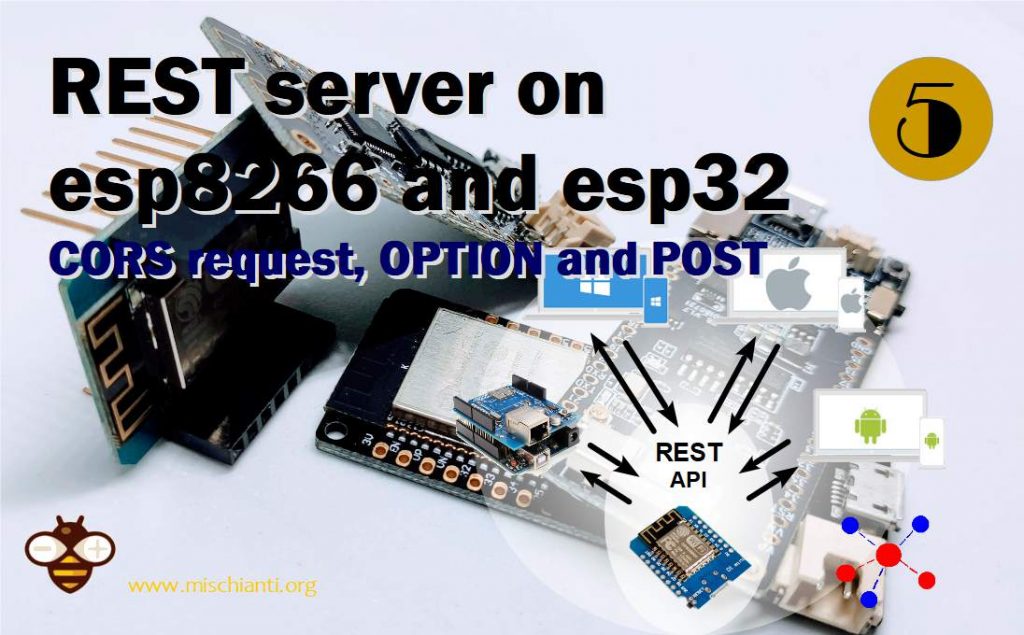How to create a REST server on esp8266 or esp32: CORS request, OPTION and POST - Part 5 (original) (raw)
As I already write in the previous article there are some security policy that we can’t ignored. The most important one is that if you want do a REST call to a server from another server, with different domain (or orign if you prefer) you enter in the tunnel of CORS.

REST server on esp8266 and esp32 CORS request OPTION and POST
Cross-Origin Resource Sharing (CORS) is a mechanism that uses additional HTTP headers to tell browsers to give a web application running at one origin, access to selected resources from a different origin. A web application executes a cross-origin HTTP request when it requests a resource that has a different origin (domain, protocol, or port) from its own. (Cit.)
In the last article I showed how it is possible to bypass the CORS policy for the GET, now we will go to see how a POST needs more information.
Refer to the previour article for the base sketch to modify.
Manage CORS POST
At the same manner o the GET we are going to manage a POST.

REST server on esp8266 and esp32 the tunnel of CORS
I created a simple html file with a POST.
Do POST requestAnd now create the POST with all previous consideration.
Here the routing
// Define routing void restServerRouting() { server.on("/", HTTP_GET, { server.send(200, F("text/html"), F("Welcome to the REST Web Server")); }); server.on(F("/helloWorld"), HTTP_GET, getHelloWord); server.on(F("/settings"), HTTP_OPTIONS, sendCrossOriginHeader); server.on(F("/settings"), HTTP_GET, getSettings);
server.on(F("/settings"), HTTP_POST, setSettings);}
Here the setSettings post consumer.
void setSettings() { // expected // {"ip":"192.168.1.129","gw":"192.168.1.1","nm":"255.255.255.0"} Serial.println(F("postConfigFile"));
setCrossOrigin();
String postBody = server.arg("plain");
Serial.println(postBody);
DynamicJsonDocument doc(512);
DeserializationError error = deserializeJson(doc, postBody);
if (error) {
// if the file didn't open, print an error:
Serial.print(F("Error parsing JSON "));
Serial.println(error.c_str());
String msg = error.c_str();
server.send(400, F("text/html"), "Error in parsin json body! <br>"+msg);
}else{
JsonObject postObj = doc.as<JsonObject>();
Serial.print(F("HTTP Method: "));
Serial.println(server.method());
if (server.method() == HTTP_POST) {
if ((postObj.containsKey("ip"))) {
Serial.print(F("Open config file..."));
// Here you can open your file to store your config
// Now I simulate It and set configFile a true
bool configFile = true;
if (!configFile) {
Serial.println(F("fail."));
server.send(304, F("text/html"), F("Fail to store data, can't open file!"));
}else{
Serial.println(F("done."));
const char* address = postObj[F("ip")];
const char* gatway = postObj[F("gw")];
const char* netMask = postObj[F("nm")];
Serial.print("ip: ");
Serial.println(address);
Serial.print("gw: ");
Serial.println(gatway);
Serial.print("nm: ");
Serial.println(netMask);// server.sendHeader("Content-Length", String(postBody.length())); server.send(201, F("application/json"), postBody);
// Serial.println(F("Sent reset page")); // delay(5000); // ESP.restart(); // delay(2000); } } else { server.send(204, F("text/html"), F("No data found, or incorrect!")); } } } }
And now we’re going to do the POST, but we’ll have a surprise.
index.html?_ijt=j45g17rditk4jvsopqbsb6mohs:1 Access to XMLHttpRequest at 'http://192.168.1.129/settings' from origin 'http://localhost:63342' has been blocked by CORS policy: Response to preflight request doesn't pass access control check: No 'Access-Control-Allow-Origin' header is present on the requested resource.
There is a CORS error, because GET request need CORS header only in GET response, POST want to be allowed by OPTION, so we are going to add CORS header in OPTION.
void sendCrossOriginHeader(){ Serial.println(F("sendCORSHeader")); server.sendHeader(F("access-control-allow-credentials"), F("false")); setCrossOrigin(); server.send(204); }
Now if we retry all work as expected.
Normal response {"ip":"192.168.1.123","gw":"192.168.1.1","nm":"192.168.1.255"} Error response
Here the complete sketch.
For esp32 you must only change this include
#include <ESP8266WiFi.h> #include <ESP8266WebServer.h> #include <ESP8266mDNS.h>
to
#include <WiFi.h> #include <WebServer.h> #include <ESPmDNS.h>
and chip information like so
doc["chipRevision"] = ESP.getChipRevision();
doc["flashChipMode"] = ESP.getFlashChipMode();
doc["flashChipSize"] = ESP.getFlashChipSize();
doc["flashChipSpeed"] = ESP.getFlashChipSpeed();/*
Json parametric GET REST response with ArduinoJSON library- by Mischianti Renzo https://mischianti.org
- https://mischianti.org/
- */
#include "Arduino.h" #include <ESP8266WiFi.h> #include <WiFiClient.h> #include <ESP8266WebServer.h> #include <ESP8266mDNS.h> #include <ArduinoJson.h>
const char* ssid = ""; const char* password = "";
ESP8266WebServer server(80);
void setCrossOrigin(){ server.sendHeader(F("Access-Control-Allow-Origin"), F("")); server.sendHeader(F("Access-Control-Max-Age"), F("600")); server.sendHeader(F("Access-Control-Allow-Methods"), F("PUT,POST,GET,OPTIONS")); server.sendHeader(F("Access-Control-Allow-Headers"), F("")); };
// Serving Hello world void getHelloWord() { DynamicJsonDocument doc(512); doc["name"] = "Hello world";
Serial.print(F("Stream..."));
String buf;
serializeJson(doc, buf);
server.send(200, "application/json", buf);
Serial.print(F("done."));}
// Serving Hello world void getSettings() { setCrossOrigin(); // // Allocate a temporary JsonDocument // Don't forget to change the capacity to match your requirements. // Use arduinojson.org/v6/assistant to compute the capacity. // StaticJsonDocument<512> doc; // You can use DynamicJsonDocument as well DynamicJsonDocument doc(512);
doc["ip"] = WiFi.localIP().toString();
doc["gw"] = WiFi.gatewayIP().toString();
doc["nm"] = WiFi.subnetMask().toString();
if (server.arg("signalStrength")== "true"){
doc["signalStrengh"] = WiFi.RSSI();
}
if (server.arg("chipInfo")== "true"){
doc["chipId"] = ESP.getChipId();
doc["flashChipId"] = ESP.getFlashChipId();
doc["flashChipSize"] = ESP.getFlashChipSize();
doc["flashChipRealSize"] = ESP.getFlashChipRealSize();
}
if (server.arg("freeHeap")== "true"){
doc["freeHeap"] = ESP.getFreeHeap();
}
Serial.print(F("Stream..."));
String buf;
serializeJson(doc, buf);
server.send(200, F("application/json"), buf);
Serial.print(F("done."));}
void setSettings() { // expected // {"ip":"192.168.1.129","gw":"192.168.1.1","nm":"255.255.255.0"} Serial.println(F("postConfigFile"));
setCrossOrigin();
String postBody = server.arg("plain");
Serial.println(postBody);
DynamicJsonDocument doc(512);
DeserializationError error = deserializeJson(doc, postBody);
if (error) {
// if the file didn't open, print an error:
Serial.print(F("Error parsing JSON "));
Serial.println(error.c_str());
String msg = error.c_str();
server.send(400, F("text/html"), "Error in parsin json body! <br>"+msg);
}else{
JsonObject postObj = doc.as<JsonObject>();
Serial.print(F("HTTP Method: "));
Serial.println(server.method());
if (server.method() == HTTP_POST) {
if ((postObj.containsKey("ip"))) {
Serial.print(F("Open config file..."));
// Here you can open your file to store your config
// Now I simulate It and set configFile a true
bool configFile = true;
if (!configFile) {
Serial.println(F("fail."));
server.send(304, F("text/html"), F("Fail to store data, can't open file!"));
}else{
Serial.println(F("done."));
const char* address = postObj[F("ip")];
const char* gatway = postObj[F("gw")];
const char* netMask = postObj[F("nm")];
Serial.print("ip: ");
Serial.println(address);
Serial.print("gw: ");
Serial.println(gatway);
Serial.print("nm: ");
Serial.println(netMask);// server.sendHeader("Content-Length", String(postBody.length())); server.send(201, F("application/json"), postBody);
// Serial.println(F("Sent reset page")); // delay(5000); // ESP.restart(); // delay(2000); } } else { server.send(204, F("text/html"), F("No data found, or incorrect!")); } } } }
void sendCrossOriginHeader(){ Serial.println(F("sendCORSHeader"));
server.sendHeader(F("access-control-allow-credentials"), F("false"));
setCrossOrigin();
server.send(204);}
// Define routing void restServerRouting() { server.on("/", HTTP_GET, { server.send(200, F("text/html"), F("Welcome to the REST Web Server")); }); server.on(F("/helloWorld"), HTTP_GET, getHelloWord); server.on(F("/settings"), HTTP_OPTIONS, sendCrossOriginHeader); server.on(F("/settings"), HTTP_GET, getSettings);
server.on(F("/settings"), HTTP_POST, setSettings);}
// Manage not found URL void handleNotFound() { String message = "File Not Found\n\n"; message += "URI: "; message += server.uri(); message += "\nMethod: "; message += (server.method() == HTTP_GET) ? "GET" : "POST"; message += "\nArguments: "; message += server.args(); message += "\n"; for (uint8_t i = 0; i < server.args(); i++) { message += " " + server.argName(i) + ": " + server.arg(i) + "\n"; } server.send(404, "text/plain", message); }
void setup(void) { Serial.begin(115200); WiFi.mode(WIFI_STA); WiFi.begin(ssid, password); Serial.println("");
// Wait for connection while (WiFi.status() != WL_CONNECTED) { delay(500); Serial.print("."); } Serial.println(""); Serial.print("Connected to "); Serial.println(ssid); Serial.print("IP address: "); Serial.println(WiFi.localIP());
// Activate mDNS this is used to be able to connect to the server // with local DNS hostmane esp8266.local if (MDNS.begin("esp8266")) { Serial.println("MDNS responder started"); }
// Set server routing restServerRouting(); // Set not found response server.onNotFound(handleNotFound); // Start server server.begin(); Serial.println("HTTP server started"); }
void loop(void) { server.handleClient(); }